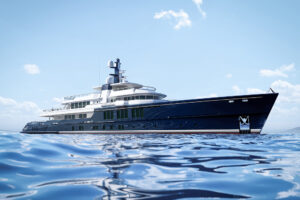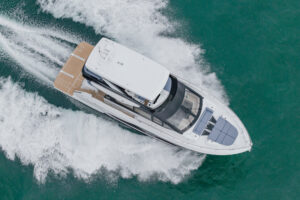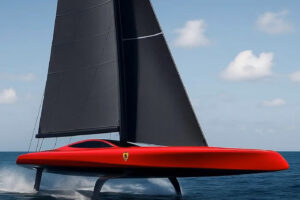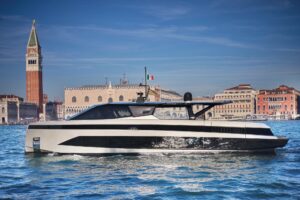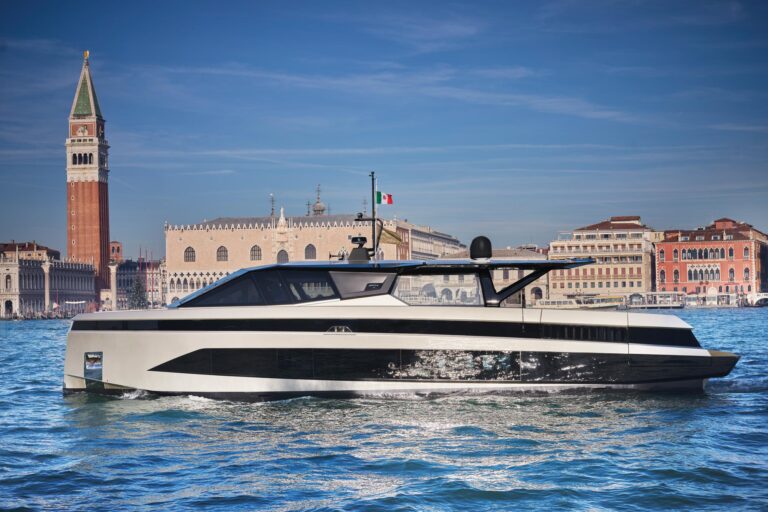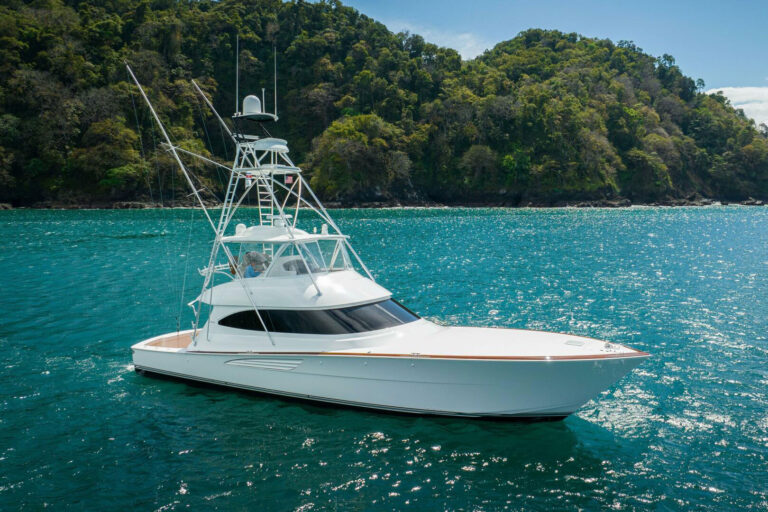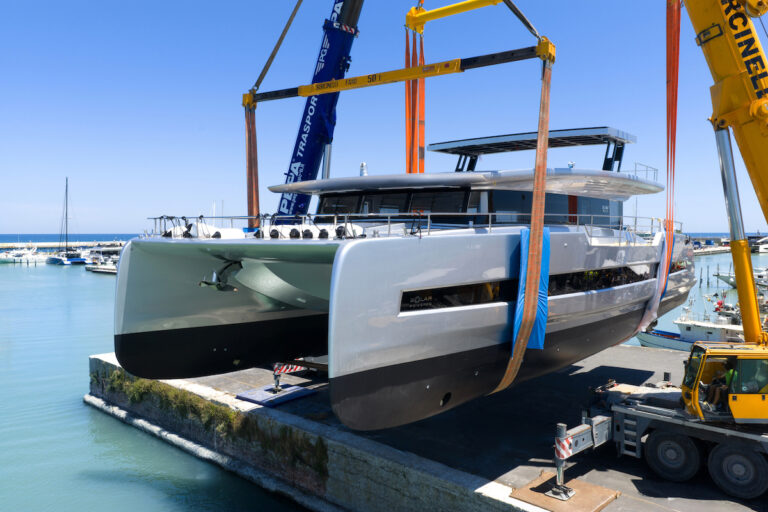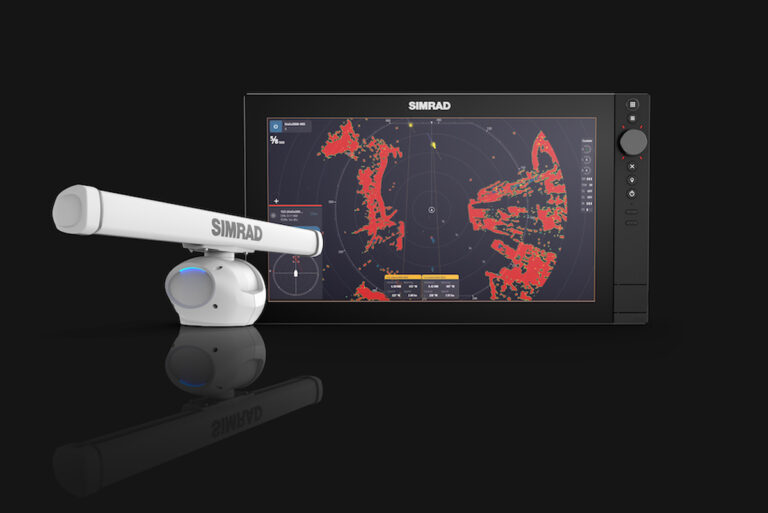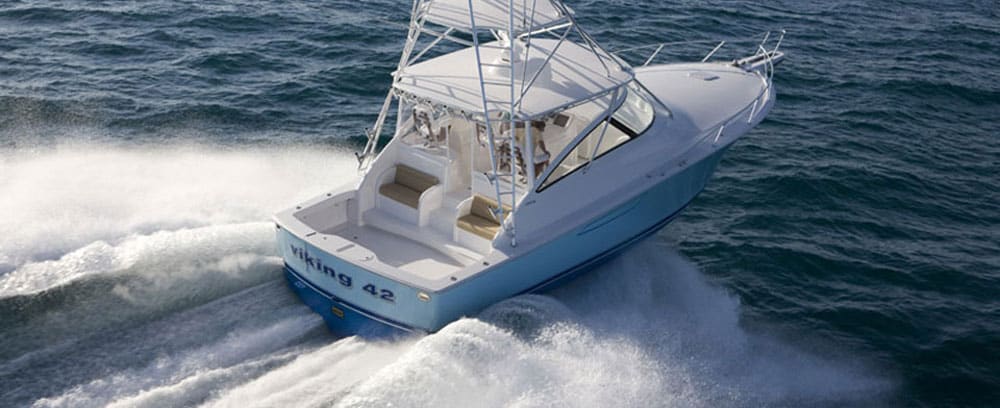
Viking 42 Open
In a game of free-word association, the one that comes to mind for the new Viking 42 Open is circle. A strange thought at first consideration, given the boat’s triangulated tower and sharp forefoot. But to me it makes sense.
Maybe it’s the Zeus propulsion system that can spin the boat around within its own length. Or maybe it’s the stellar 360-degree view from the Palm Beach-style helm on the command deck. Or it could be that Viking is building a 42-footer, returning to a model size evocative of its classic 40 convertible from nearly 40 years ago (see our complete photo gallery here).
While not the first time Viking has built something in the 40-foot range, it is (along with the sister 42 Convertible) the first time the company has built a boat with pod-drives. Or, I should say, specifically for pod-drive installation. The fact that a traditional builder such as Viking has taken the plunge shows that pods are going mainstream. Viking has its reasons. “A lot of our 42 customers are moving up from large center consoles,” said Peter Frederiksen, Viking’s director of communications. “The pods take away the intimidation of moving from outboards to inboards.”
Viking designers worked with Cummins MerCruiser Diesel representatives from the first CAD drawing to perfect the balance and weight distribution within the boat, and to shape the pocket tunnels in the hull that house the drives. The results can be seen both above and below deck in the finished product.
The most obvious benefit revealed itself within the first three seconds of our sea trial at the Viking Yachts Service Center in Palm Beach, Florida, when captain Ryan Higgins worked the joystick to glide us out of our slip. He then crabbed the boat sideways until we had enough water to swing the bow and head out to the Intracoastal Waterway. “That’s the worst slip in the facility,” Frederiksen said, as Higgins made it look easy.
As we powered onto plane, the Zeus system’s integrated automated trim tabs helped us pop out of the hole with minimal bow rise and maintain an optimal running angle as we accelerated. Standing at the helm, I found no blind spots while surveying the water for boats and channel markers. The entire command deck is set up to ensure the captain’s line of sight is not obscured by hardware or fellow passengers, with comfortable bench seats running along either side and two additional helm chairs tucked into the aft corners. The lines are clean and simple, and the captain has an easy view of the cockpit, as well as quick access to the action through the mezzanine.
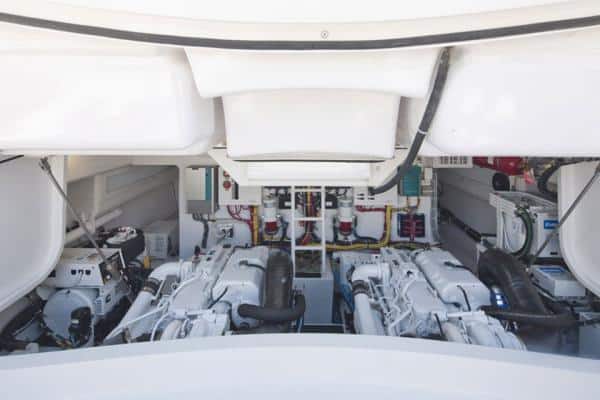
The entire mezzanine rises via two 500-pound hydraulic pistons, which Higgins actuated by pressing a remote-control key fob as we stood in the cockpit. The hatch opened to reveal a clean, well-appointed engine room finished with Awlgrip. All service points for the Cummins diesels were easily accessible, and a look at the ship’s systems showed Viking’s attention to detail. All wiring, made in-house, is clearly labeled every eight inches along its insulation, so anyone performing maintenance or repairs knows exactly where it goes. Access to the service points for the pod-drives is under cockpit hatches, which resemble in-sole tuna doors.
On the 42 Open, Viking capitalized on another aspect of pod-drives: fuel load distribution. Because the engines are mounted farther aft, Viking was able to build a single fuel tank along the boat’s center of gravity. “Unlike the typical boat that might lift on the stern as you burn fuel, this boat rises level,” Higgins said.
When we pointed the bow toward the Palm Beach inlet, into four- to six-footers stacked up against the outgoing tide, we had the perfect opportunity to test the 42 Open’s seakeeping abilities. The boat took on a head sea and quartering sea with aplomb, landing in the troughs with a solid mush, and not a single rattle emanated from the Palm Beach tower. Higgins explained that the company built the 42 with a deeper V than on the typical Viking (16.7 degrees of deadrise at the transom compared with 10 or 11 degrees) to compensate for the shorter running length and lighter weight. The additional draft from the V is offset by the shallow running gear of the pod-drives, nestled in protective pockets; the 42 Open floats in 3 feet, 5 inches of water.
Above the waterline, the 42 Open is typical Viking, with the same finish and hardware found on the builder’s larger boats. The components are cut to precision on one of the two five-axis profilers at Viking’s facility in New Gretna, New Jersey. The hatches are made by resin transfer molding, and the teak hardwood and veneer give the area belowdecks an elegant appearance.
Our test vessel had the standard two-stateroom configuration, which features a master in the bow, a full head with a separate stand-up shower, a galley and a salon. The guest stateroom sits amidships, built into the space gained by the pod-drive installation. It features two side-by-side single berths and more than six feet of headroom. Viking offers the option of a third stateroom and a guest head to port, opposite the galley, with an over-under bunk. (With this setup, though, you lose the salon and a little bit of space in the master stateroom.) The galley features plenty of usable counter space, with Corian stretching along the aft bulkhead and the starboard wall. I really liked the Amtico vinyl flooring, which looks like teak but will be much easier to maintain.

One thing I noticed on our tour belowdecks: There’s no way to access the anchor locker from the master stateroom if a problem arises with the optional Lewmar windlass — that’s because it’s not needed. The bow locker setup allows for excellent access to the anchor rode, so you’ll never have to kneel on your mattress to deal with a dirty, stuck chain.
Of course, the Skyhook feature, part of the Zeus system, obviates the need for an anchor in some situations. Press a button and pods work to hold the boat in place. We tried it with success offshore in rough seas, but it works best while waiting for space at the fuel dock or for a bridge to open. Or you could just play with the joystick and spin the boat in place in a circle.
See our complete photo gallery here.
LOA: 42’7″
LWL: 35’7″
BEAM: 15’10”
DRAFT: 3’5″
DISPL.: 32,699 lb.
FUEL: 525 gal.
WATER: 120 gal.
DEADRISE: 16.7 degrees
STANDARD POWER: 2 x 440 hp Cummins QSB diesels with Zeus drives
TEST POWER: 2 x 600 hp
Cummins QSC diesels with Zeus drives
BASE PRICE: $941,420
PRICE AS TESTED: $1,200,386
Test conditions: Speeds were measured by GPS in the Intracoastal Waterway in Palm Beach, Florida, with calm seas and 17-knot winds, with a 3/5 load of fuel, full water and three people on board. Fuel consumption was calculated by the electronic engine-monitoring system. Sound levels were measured at the helm.
RPM Knots GPH dB(A)
600 5.4 1.1 73
900 7.5 2.9 75
1200 9.0 6.9 83
1500 10.1 14.4 86
1800 15.0 24.3 85
2100 21.2 29.1 90
2400 26.0 35.2 89
2700 30.9 43.7 91
3080 35.7 62.4 95
Viking Yachts, 609-296-6000; www.vikingyachts.com

